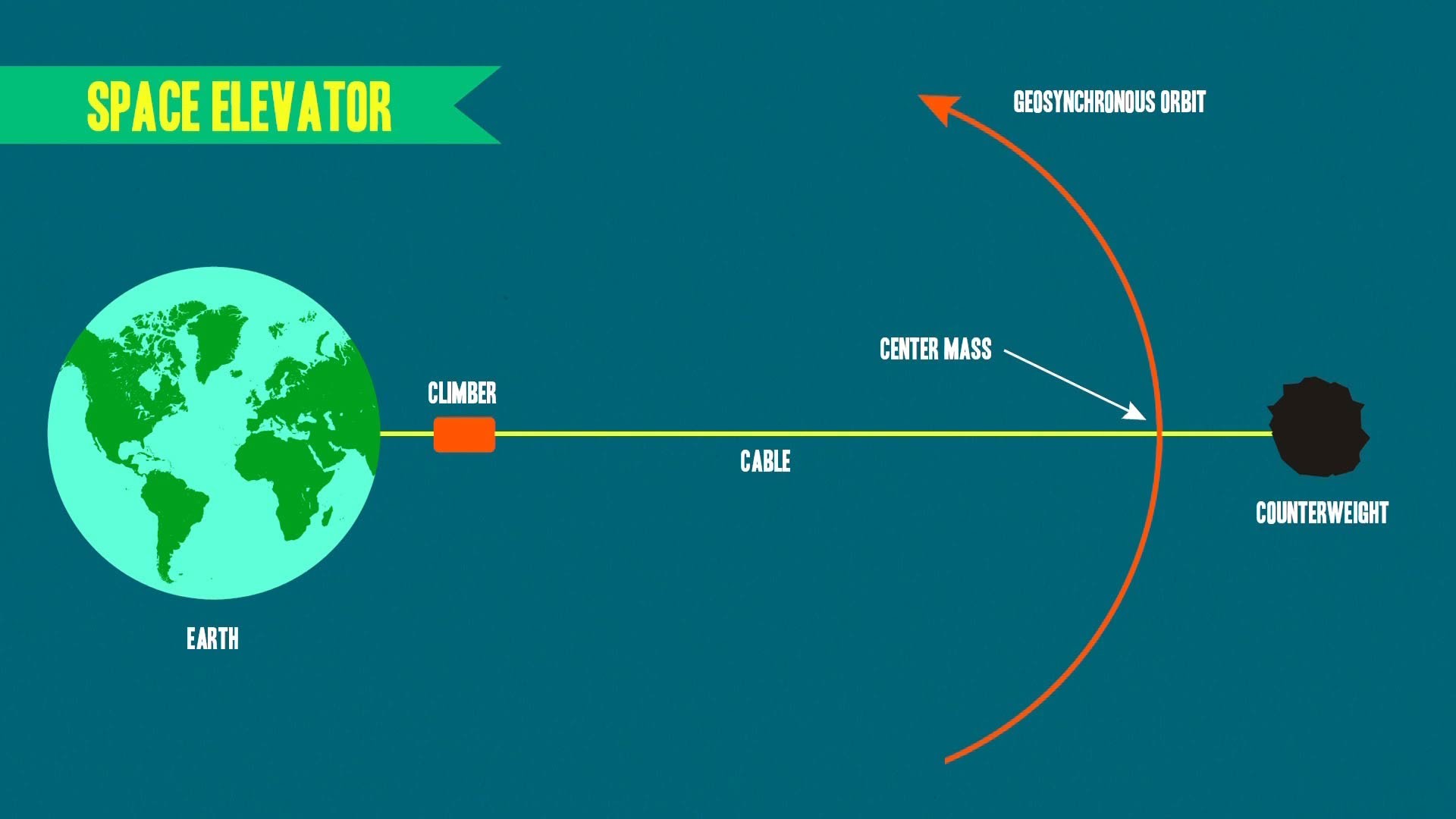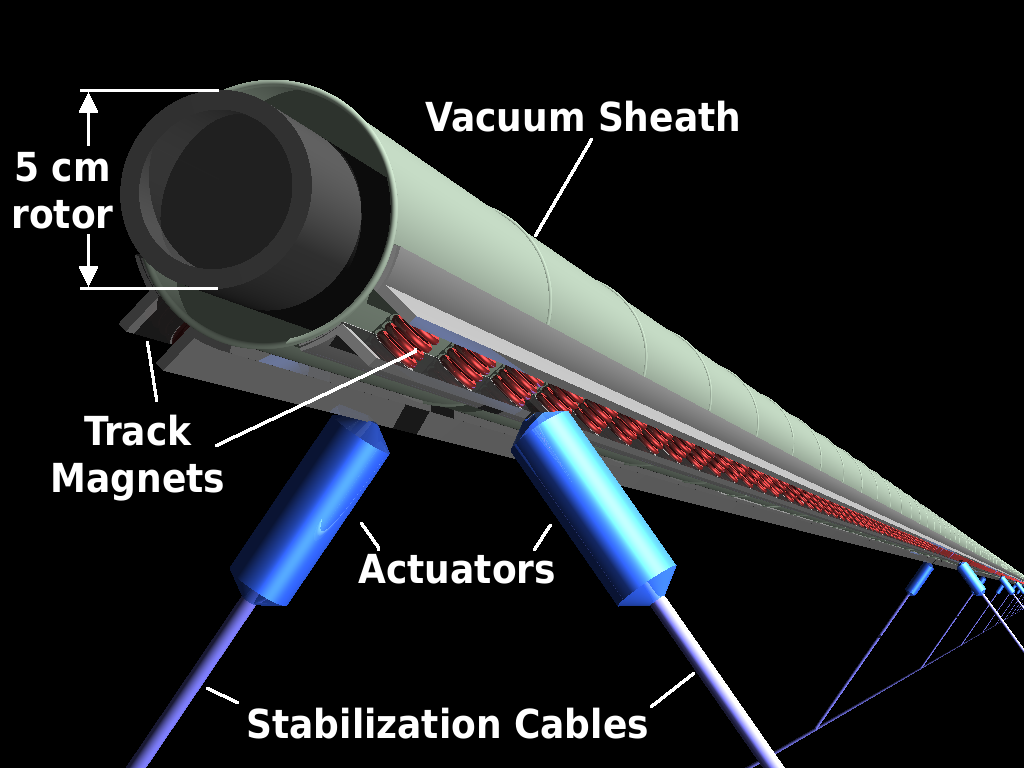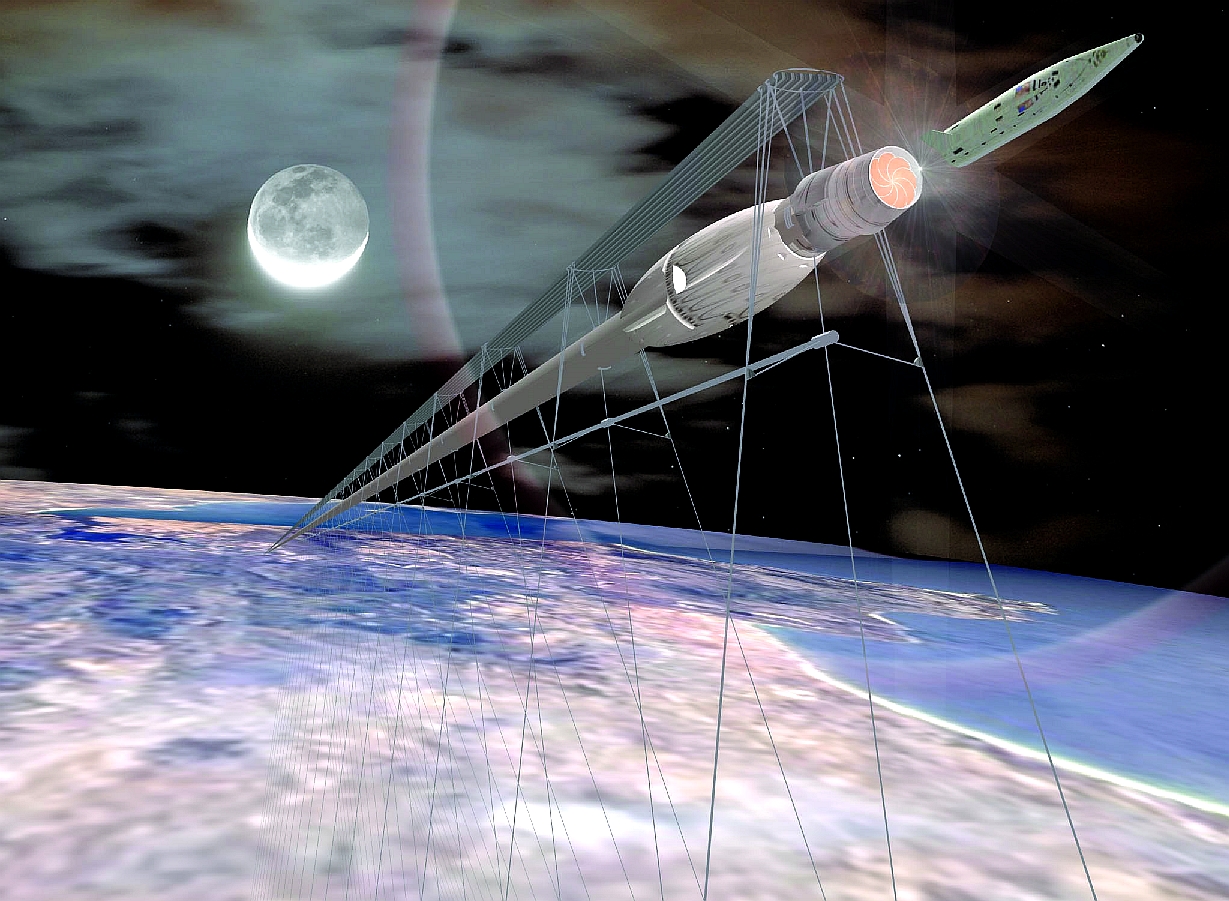Alternatives to Rockets: Space Elevators, Launch Loops, Startram
The only way to get launch costs down to low levels for transporting people, is to impart a large part, or even all, of the kinetic energy from a fixed point on earth or in orbit, to avoid moving all that fuel.
Space Elevator Several options have been suggested. The most publicised is the Space Elevator.A very long cable stretches from the ground to geostationary orbit (36,000 kms) with a counterweight beyond, and vehicles can travel up it by elevators. In theory very low cost transport, no more than an intercontinental flight. However the cable has to be over 36,000 kms long (!), any break destroys it (with unpleasant consequences for those below…) and we don’t currently have any materials strong enough. Carbon nano tubes might do it, but even they would be near a structural limit. Also moving up the cable with an elevator at relatively slow speeds would expose passengers to the radiation from the Van Allen belts, although they could be shielded from this. I think that this a non starter, for the immediate and possibly even long term future.
 Source: https://www.youtube.com/watch?v=_2M73aXuORI
Source: https://www.youtube.com/watch?v=_2M73aXuORI
Launch Loop To reach escape velocity, you need a means to accelerate a launch vehicle rapidly - but if you are doing from the ground there is another problem. A vehicle trying to reach escape velocity would simply burn up due to air resistance. One way to deal with this is to do so on a track supported above most of the atmosphere.
One idea feasible with current materials is the Launch Loop.
 Source: http://www.orionsarm.com/eg-article/4684534627504
Source: http://www.orionsarm.com/eg-article/4684534627504
A long horizontal tube is supported at 80kms height above the ground (above most of the atmosphere) by a flexible iron rotor in a vacuum tube which is moved through the tube magnetically.
 Source: Keith Loftstrom
Source: Keith Loftstrom
A launch vehicle on top of the tube is accelerated by drawing energy from the rotor. If the suspended tube is 2000kms long, then acceleration at 3g ( the maximum that is comfortable for untrained humans) will reach escape velocity to low Earth orbit.
Technically the launch loop presents far fewer problems than a space elevator. The launch vehicle only needs fuel on board to manoeuvre in orbit, so potential launch operating costs are very low, not much more than an intercontinental flight today. This is particularly the case if spacecraft returning to Earth land on the launch loop, in the reverse direction (west to east) regenerative braking would capture some of the kinetic energy of re-entry otherwise dissipated as heat; this would however require very precise positioning of the returning vehicle millimetres above the track at very high speeds.
Inventor of the idea Keith Lofstrom suggests placing the track over the sea close to the equator, where there is maximum benefit from the Earth’s rotation. Some suggested tracks are shown in the image below, away from the zones subject to tropical cyclones and ideally away from shipping lanes.
 Source: Keith Lofstrom. The feathery blue and white lines are the tracks of tropical cyclones/hurricanes.
Source: Keith Lofstrom. The feathery blue and white lines are the tracks of tropical cyclones/hurricanes.
However stringing a 2000kms long system, anchored under the sea – impervious to storms or collisions from stray ships? An alternative is to put the launch loop west to east along stretches of uninhabited desert. Suitable stretches are in the Sahara, Kazakhstan, China (Gobi desert), and Australia. These are mid latitudes rather than equatorial, so less benefit on launch from the Earth’s rotation, but this would be more than made up by ease of construction and maintenance compared to over the sea; note that the two most used current launch sites, Cape Canaveral in the USA and Baikonur in Kazakhstan are in mid latitudes.
There are two major problems with the launch loop concept. Any break, destroys it, not simple to patch up. Above all, it is kept up by a rotor travelling in a vacuum tube at faster than escape velocity. If anything goes wrong a huge amount of kinetic energy, equivalent to a small nuclear bomb, is released. It would be essential to ensure that a launch loop is fail safe - that not all that energy is released in one go if anything goes wrong. This would not be easy to do.
The capital costs for a launch loop would be substantial (not just the loop itself, but also ancillary power station, airport/spaceport, if over sea probably deep water artificial islands, maintenance facilities). It only makes sense with high volumes of traffic, not something that will happen anytime soon, but long term very interesting.
Startram An alternative to using a power loop is to use linear motors to provide the acceleration. This avoids the safety risks of the launch loop rotor, but linear motors would probably be heavier, more expensive, and require more maintenance. It has been proposed under the name of Startram. A long vacuum tube on the desert floor accelerates a launch vehicle with linear motors to beyond escape velocity. The last few kilometres are elevated by magnetic repulsion to ~20 kms. The tube is kept at vacuum with magneto hydrodynamic pumps which allows the exit to remain open. At 20kms height there is still enough air to provide an immediate 3g deceleration, but this only lasts a brief time.
The vacuum tube would have to be very large and heavy, and can magnetic repulsion as suggested be enough to lift the tube towards the end? If it does not then the exit from the tube is low enough to be supported by physical columns, perhaps aided by the pressure from a magnetically thrusted stream of iron particles (the space fountain concept) Startram would have higher capital costs than a Launchloop, and regenerative braking does not seem an option, but it seems inherently safer. It also can be shorter than the Launchloop to reach LEO escape velocity, only just over 1000kms. The launchloop rotor pushes the track into a parabola, so the highest point is not the end of the loop, while startram is in a straight line.

The other problem with these technologies is that, at first glance, they do not conform to the sensible path of developing a radical new technology – start modestly and build up as you learn from experience. By contrast rocket development has been an incremental process going back to the V2 from World War II. Keith Lofstrom, the inventor of the Launch Loop concept, has suggested that smaller scale loops could be developed to store electrical energy, an alternative to batteries or flywheels, potentially very useful with renewable energy which is intermittent. As for Startram, the sensible route is to start with a shorter route with higher acceleration for launching freight, and then extend it later for passengers.
As regards the development of Space Elevators, there is a potential technology which permits gradual development, and it is feasible, although the cost reduction potential is smaller, as discussed in the next post.
If we ever do mine the Moon or Mars, however, space elevators can be built with existing materials, as the escape velocities are lower (8,600 and 18,100 kms/hour respectively). Indeed on the Moon you would not need a launch loop with that troublesome rotor to stay above the atmosphere, because there isn’t any. A launch ramp on the ground with linear motors will do. If accelerating at 3g (the maximum that is comfortable for normal human beings) then a mere 100km ramp would reach escape velocity on the Moon, could be shorter if just transporting minerals or goods and a higher acceleration is acceptable. Such a ramp would fit easily in to one of the lunar maria (the flat bits of the Moon).
Previous chapter:
First Step: Cost Effective Launch
Next chapter:
Alternatives to Rockets: Skyhooks